This Masala Khichdi is loaded with healthful veggies and it is deliciously spiced with garam masala and turmeric. It's the ultimate Indian comfort food!
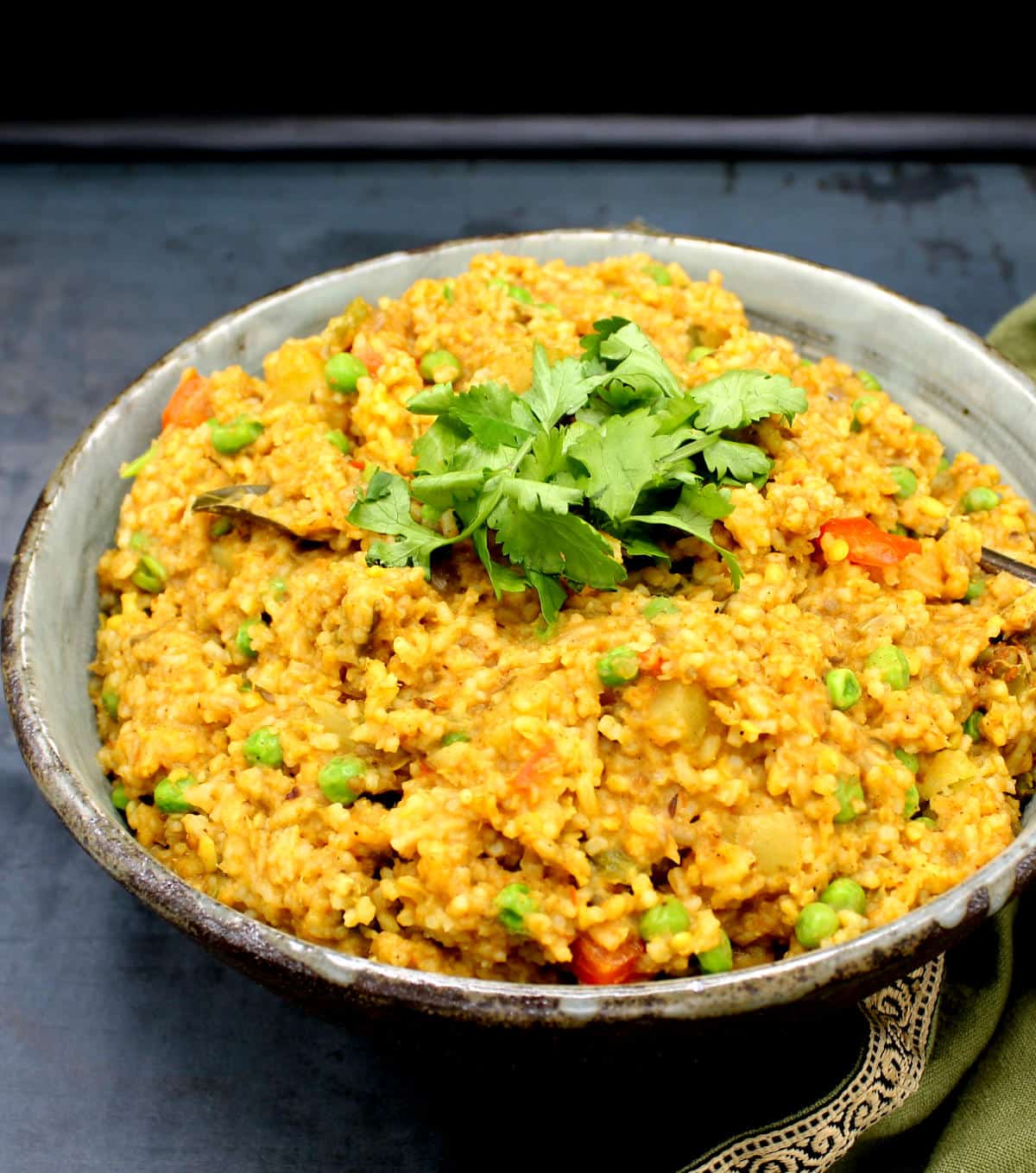
A popular one-pot meal that's cooked in just about every Indian home is a khichdi or a khichari, and those are not the only names it goes by. It's called khichuri in Bengali, kichadi in Tamil, khichri in Gujarat, and kedgeree in English (yeah, as in the language spoken by the Brits). Although the Brits, somewhere in transit, made an unnecessary addition -- fish -- to a recipe whose vegetarian deliciousness really needs no gilding.
Today, with this delicious and easy Masala Khichdi, we will take this recipe back to its roots but we'll do so with flair.
Table of Contents
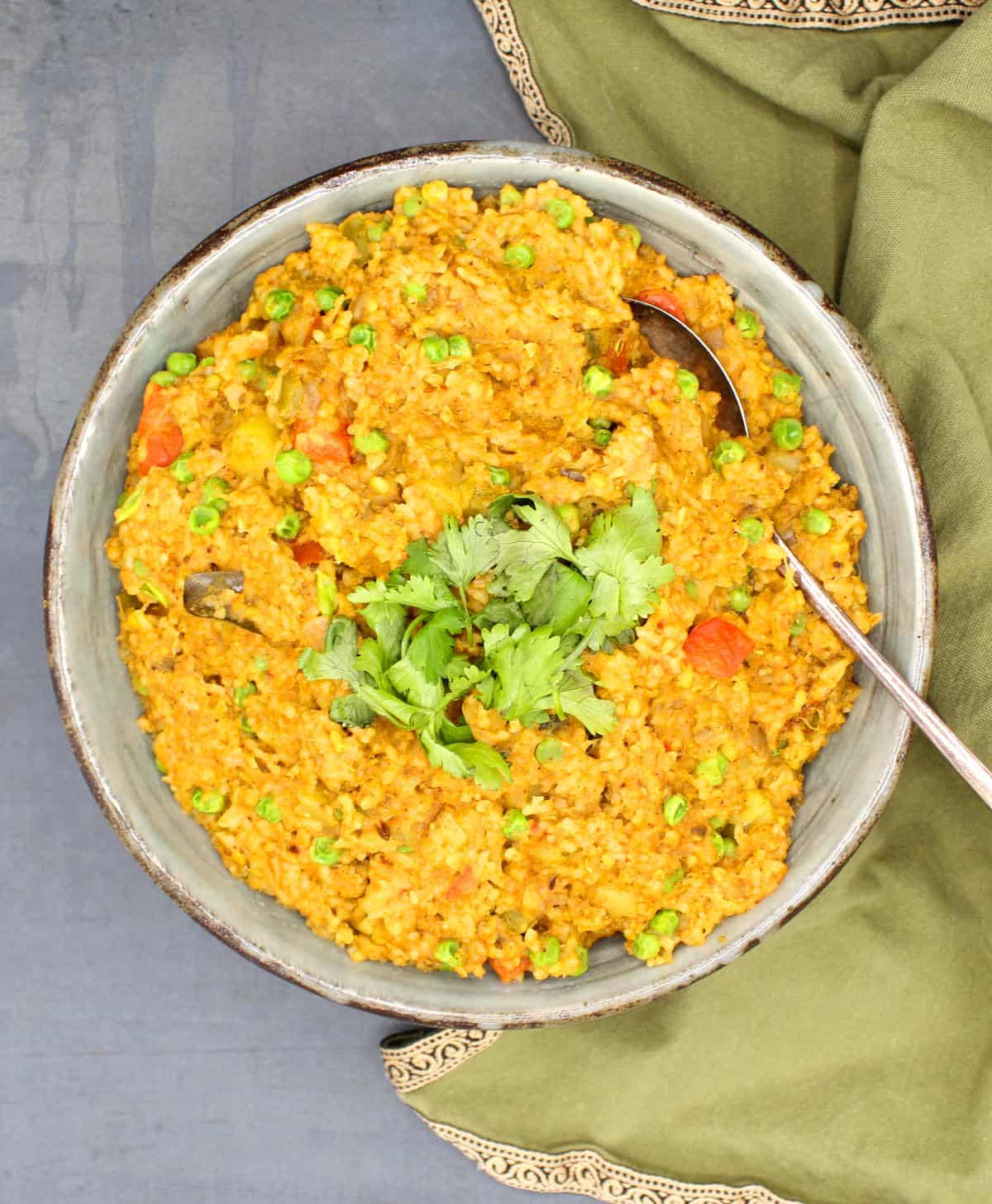
What is a khichdi?
At its very basic khichdi is a south Asian dish of lentils and rice cooked together until very soft. But this is not just the name of one dish; it's a family of hundreds of one-pot dishes that have evolved using the basic building blocks of lentils and grains. And it can include everything you'd want in a complete meal, including veggies, herbs and spices.
Over the centuries, cooks around the Indian subcontinent created versions of khichdi with whatever ingredients they had on hand or were locally available. There is a khichdi made with tapioca pearls (sabudana khichdi) that is eaten during fasts, and khichdis made with millets like jowar (sorghum) and pearl millet (bajra). There is even a keema khichdi, made with ground meat, that is said to have been invented in the kitchens of the Nizams, erstwhile royalty in the south Indian state of Andhra Pradesh. More modern versions of khichdi incorporate street-food flavors, like pav bhaji khichdi.
In the south you'd find foods like bisi bele bhath or kadamba sadam, all versions of khichdi. In Tamil Nadu, you'd celebrate the harvest with pongal, also a kind of khichdi. In the north, cooks devised dalia, a khichdi made with broken wheat. In Bengal you'd find a khichuri made with toasted moong dal. The list goes on.
The reason khichdi is so popular among Indians is because to most of us it is the ultimate comfort food. Most types of khichdi are wholesome and use few spices, if any, making them gentle on the stomach, and we learn early on to associate this food with soothing and healing. It is often the first solid food a baby eats, or the food mom would feed you if you were sick. It's the food you make in a hurry on a rushed weeknight, or the food you eat just to feel better. These healing qualities are also what has led khichdi to become associated in the west with Ayurveda, the ancient Indian form of healing.
Finally (and I have to get this out of the way because it is a pet peeve), while there are many different words and pronuciations an Indian would use to mean khichdi depending on where in India they are, what they would never call it is a "kitchari" (how do you even pronounce that?!).
If you really want to learn to say khichdi right, say it like most Indians do: "khitch-dee." It is a delightfully explosive, even onomatopoeic sound that conveys the rustic nature of this dish and the fact that this is a hodgepodge of sorts: a delicious and much loved melange with no pedigree nor defined ingredients.
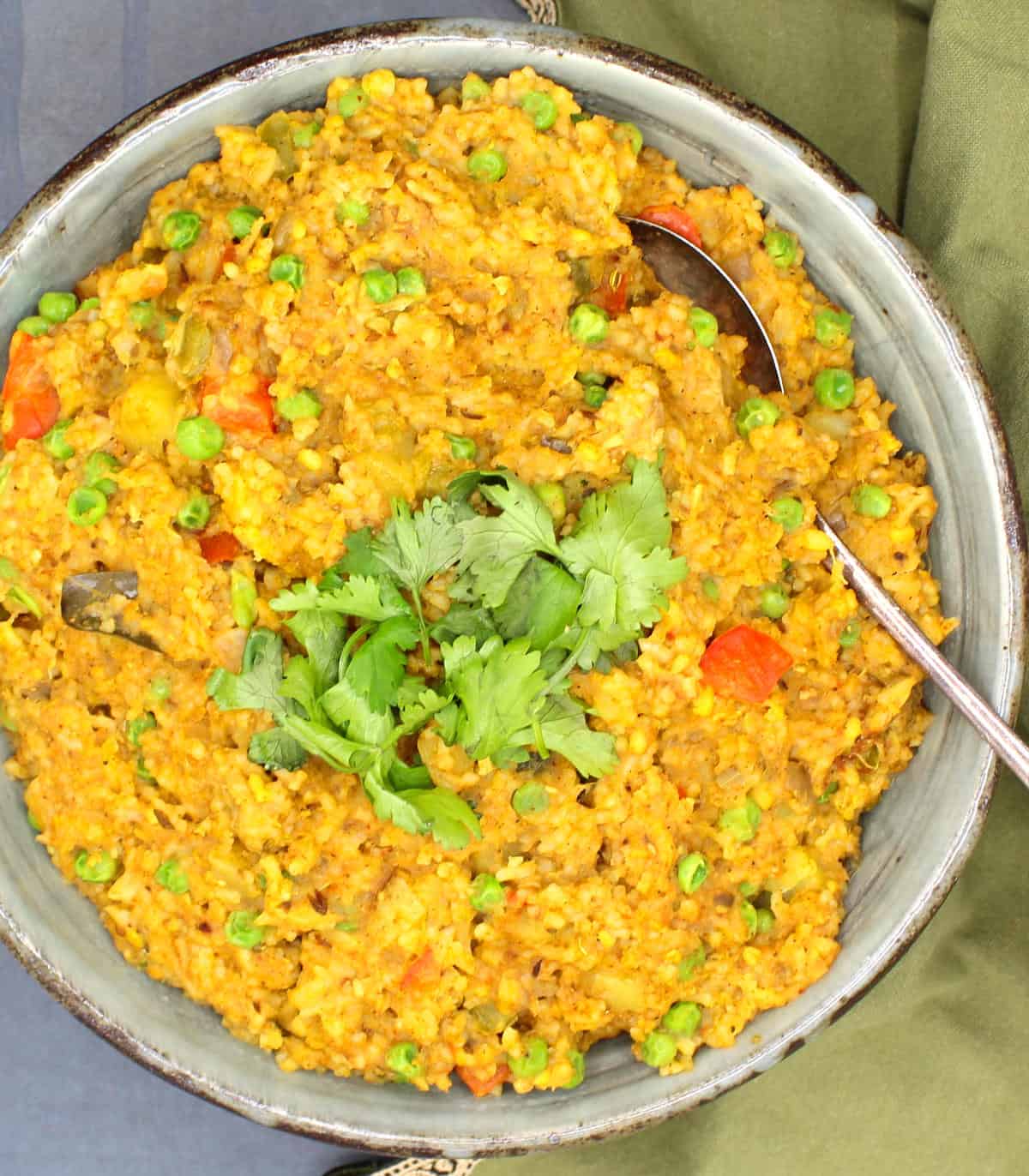
Why you'll love this Masala Khichdi
- It's delicious. As much as I love the everyday khichdi I make several times each month with just dal, rice, salt, cumin and turmeric, this masala khichdi is just as delicious and even better because it's a one-pot dish. I often make it with brown rice and it is enhanced with a ton of veggies and flavorful spices.
- It's easy. Khichdi recipes are usually easy and this one is quite foolproof. It can easily be made on the stovetop or in a pressure cooker or Instant Pot. I have included instructions for all.
- It's nutritious. As you already no doubt know from the ingredients. Dal, rice, veggies, spices: it doesn't get any healthier.
- It's a true one-pot meal. One of the reasons I love Masala Khichdi is it is not one of those dishes that pretends to be one-pot and then asks you to, erm, please serve me with this side or that or I'm just not going to taste that good! When you make this Masala Khichdi, you can rest assured that all you need is a spoon and a bowl. And if you decide to make the wise decision of serving up some poppadums and Indian pickles alongside, well, good for you!
Ingredients
- Rice. Use any rice you have around, including basmati rice, jasmine rice or even a medium grain rice. Brown rice works too.
- Moong dal. This is almost always the dal used in khichdi because moong dal is considered the coolest of dals: as in, it helps cool your body down ;). Perfect for the soothing, calming effect one is looking for with khichdi. For substitution ideas look at the FAQs below.
- Vegetable oil. Coconut oil is great here, or use another unflavored vegetable oil. Most Indian cooks would advise that you should not make a khichdi with anything but ghee, and it is true that ghee imparts a nutty flavor to khichdi that's quite delicious. But a vegan khichdi made with coconut oil can be just as tasty. To enhance it, dribble on some coconut oil over the khichdi while serving and you'll never miss the ghee.
- Cumin seeds
- Onion. Use red onions if possible, otherwise yellow are fine. Shallots are fabulous.
- Curry leaves. You don't absolutely need these, but use them if you can.
- Ginger. The warmth of ginger is gentle and healing and it's perfect in a khichdi.
- Pureed tomatoes. You can puree your own or use a canned puree.
- Vegetables. You can add as many or as few veggies as you want. I add between a cup and four cups depending on what I have on hand. This time I added a rainbow of veggies: eggplants from my garden, a green and a red bell pepper, potatoes and green peas. I didn't have any sweet potatoes on hand this time but I absolutely love them in this khichdi. You can also add squash, summer and winter, and cauliflower.
- Turmeric. For color and health.
- Cayenne or paprika. You don't want a highly spiced khichdi, because remember, it has to be gentle. But some cayenne adds a nice kick, or add paprika if you'd rather just have the color.
- Coriander powder. For lots of fresh flavor.
- Garam masala. For a touch of spice and deliciousness.
- Salt to taste
- Cilantro or mint, for garnish.
How to make masala khichdi
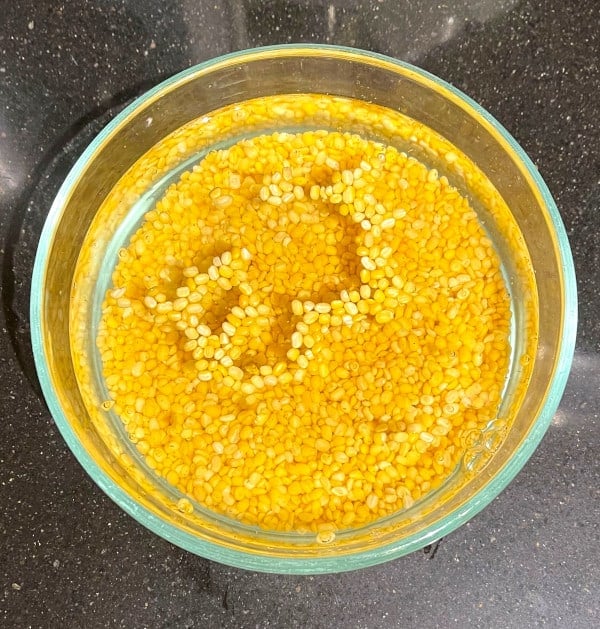
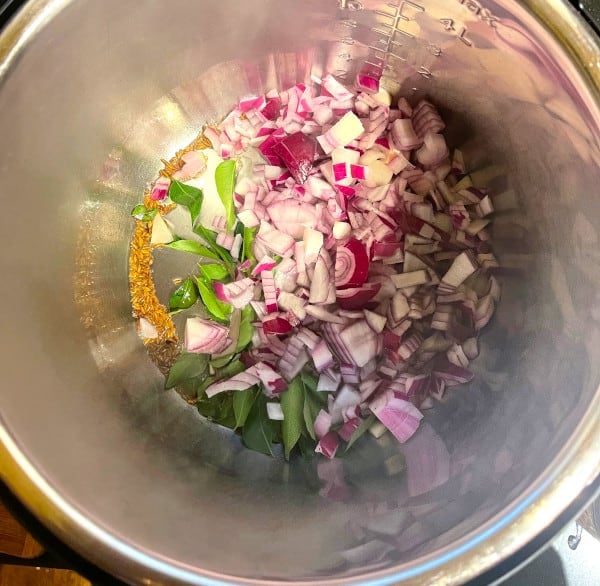
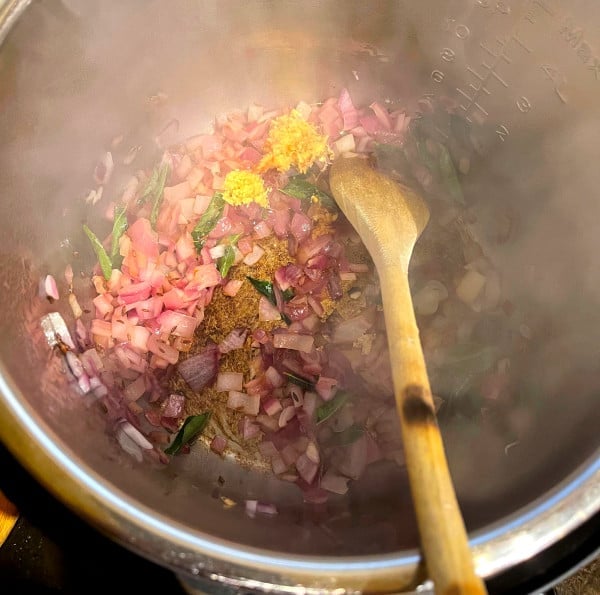
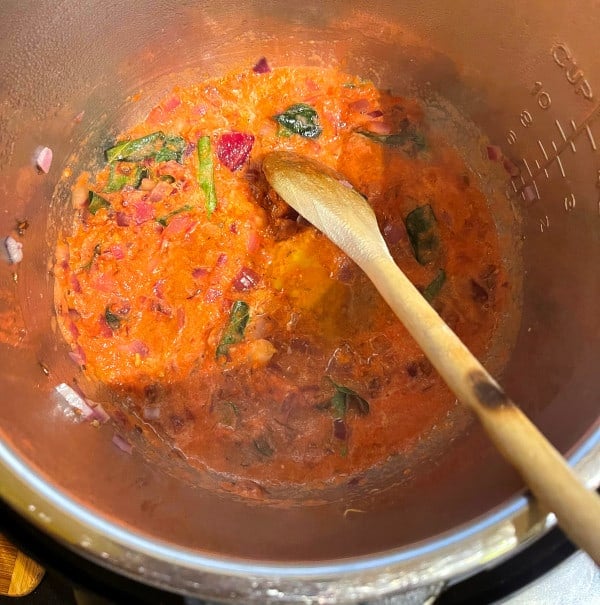
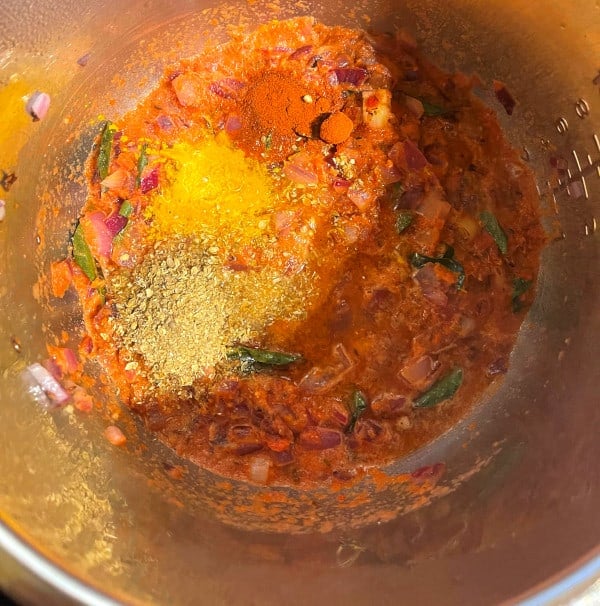
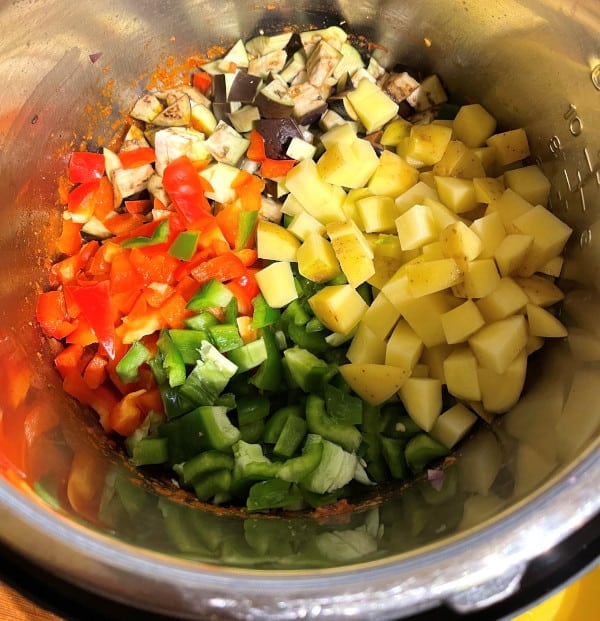
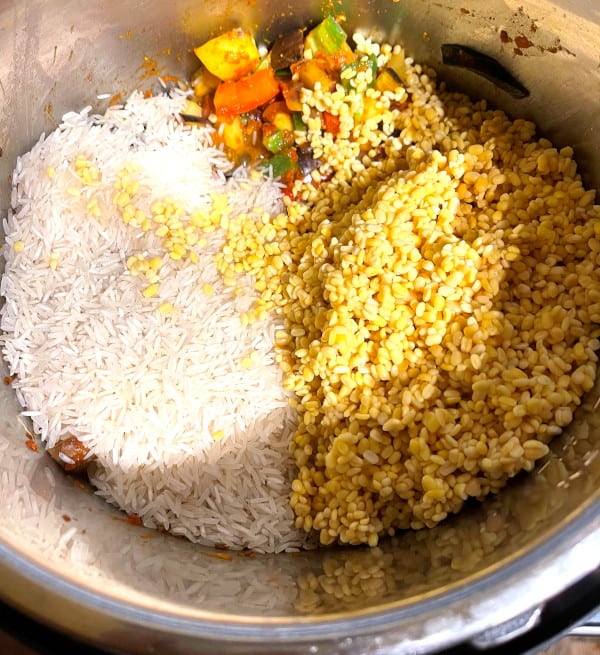
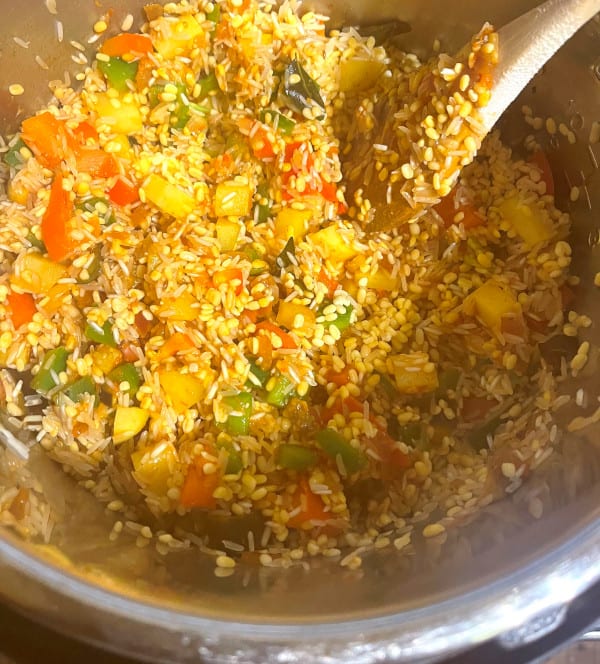
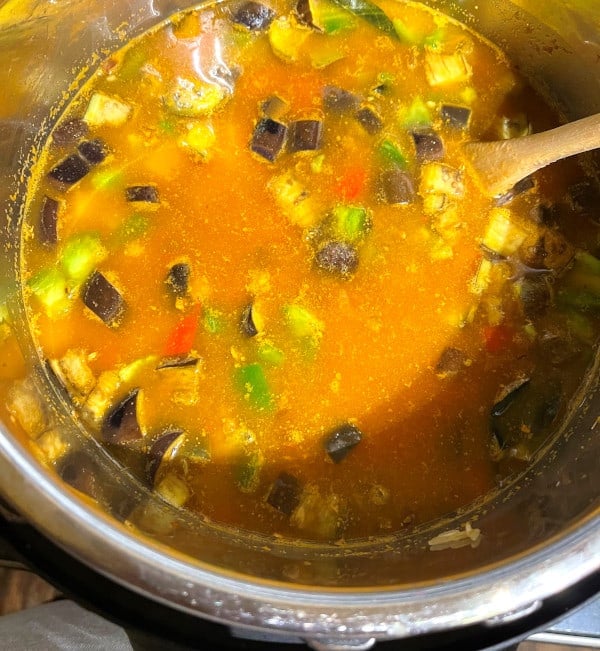
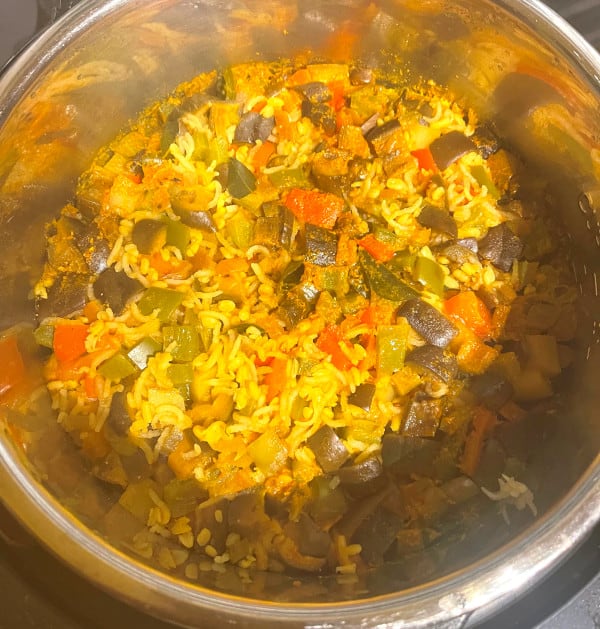
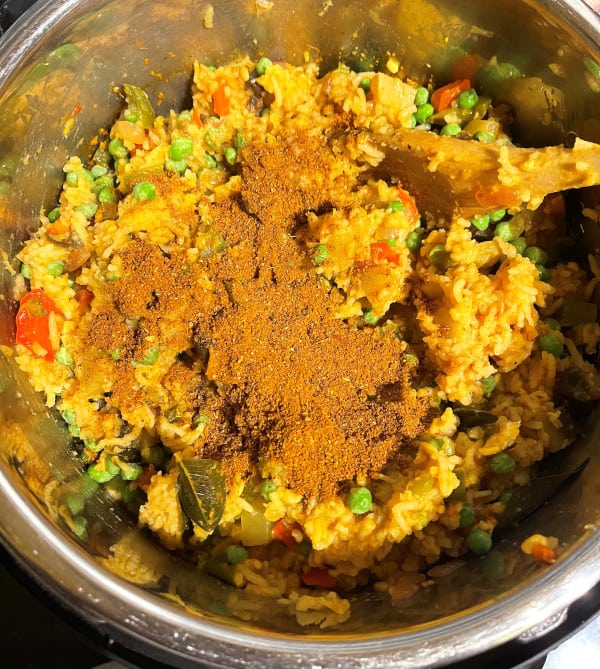
Serving suggestions
- Poppadum and lime pickle (or any Indian pickle) are the perfect sides with khichdi.
- Potatoes and khichdi get along like a house on fire, and crispy, spicy potatoes are especially wonderful. If you don't want to eat potato chips (which are great with khichdi btw), make a spicy sabzi like these Bombay Potatoes or this easy, saucy Potato Curry
- Fritters like vegetable pakoras are also wonderful with khichdi. For healthier, non-fried versions, check out these baked asparagus pakoras.
Recipe FAQs
I often use brown rice for khichdi, and when I first shared this recipe with you back in 2014 I made it with brown rice. To make the khichdi with brown rice add one more cup of water and pressure cook on high pressure in the IP for 20 minutes. In a pressure cooker go up to six whistles. On the stovetop, cook 45 minutes after the water comes to a boil, or until the grains are soft. Once your khichdi has cooked, don't be afraid to add a little more water to give it a soft, but not runny, consistency.
Moong dal is traditionally used in khichdis of all kinds around India, but not all, and you can definitely make this with another lentil. As alternatives for the moong you can use toor dal (split pigeon peas) and masoor dal (pink lentils). If using toor dal, which tends to take a bit longer to cook, soak it in water for at least an hour before cooking so it cooks at the same time as the rice.
More delicious Indian vegan rice recipes
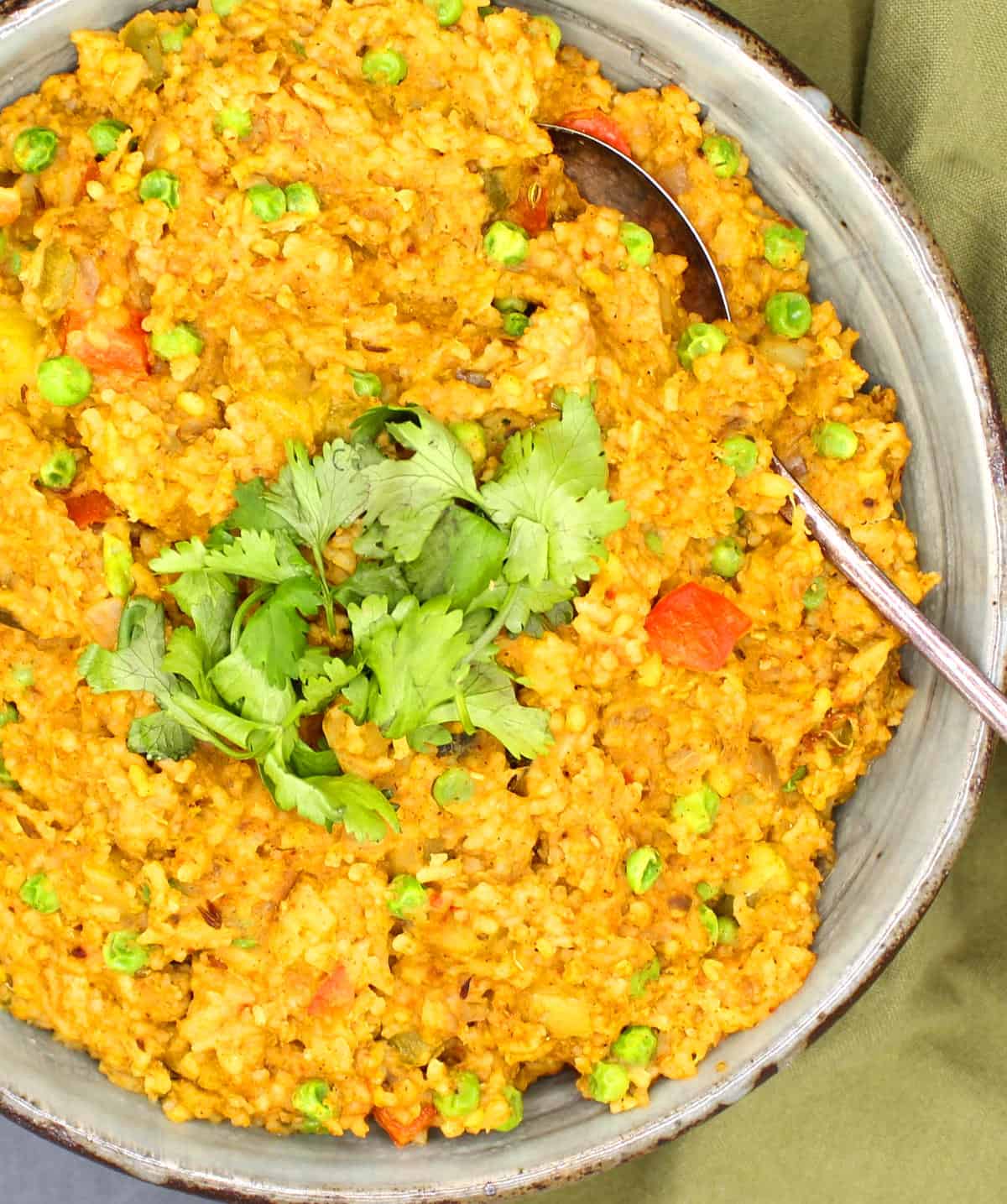

Masala Khichdi Recipe
Equipment
- Pressure cooker or Instant Pot or large Dutch oven
Ingredients
- 1 ½ cups rice
- 1 cup moong dal (soak in water when you begin to cook the khichdi, drain before adding to the pot)
- 1 teaspoon coconut oil (or any other oil, make sure you use an unflavored oil. Olive oil is a no-no)
- 1 teaspoon cumin seeds
- 1 large onion (finely chopped)
- 1 sprig curry leaves
- 1-inch knob ginger (grated or crushed)
- 1 cup tomato puree (made by pureeing two tomatoes, or use canned)
- 2 medium Italian eggplants (cut into small cubes)
- 2 bell peppers (any color, finely diced)
- 2 potatoes (any kind, cut into small cubes)
- 1 cup green peas (frozen or fresh are both fine, but look at instructions closely at each goes in at a different time)
- ½ teaspoon turmeric
- ½ teaspoon cayenne (or paprika for less heat)
- 1 tablespoon ground coriander
- 1 teaspoon garam masala
- Salt to taste
- ¼ cup cilantro (finely chopped, for garnish)
Instructions
- Heat oil in the liner of an Instant Pot set to the "saute" function or in a pressure cooker or large saucepan with a tight lid.
- Add the cumin seeds and when they sputter, add the onions and curry leaves.
- Saute, stirring, until brown spots appear on the onions. Add the ginger and saute another minute.
- Add the turmeric, cayenne or paprika and coriander powder. Stir in the tomato puree. Mix well and cook, stirring frequently, until the tomato puree darkens a couple of shades and bubbles at the corners.
- Add the vegetables. If using fresh peas add them now. If using frozen peas, you will add them later--leave them out for now.
- Add the rice and lentils to the pot and stir well. Add six cups of water. Check for salt. The water should be saltier than you want the khichdi to be.
- If you are using an Instant Pot, turn off the saute function, click on the IP lid, and set the IP to the "rice" function. If using brown rice, add an additional cup of water and increase cooking time to 20 minutes.If you're using a regular pressure cooker, pressure-cook the the khichdi for three whistles or for 10 minutes after reaching pressure. If using brown rice, cook for six whistles or for 20 minutes after reaching pressure.On the stovetop, if not using a pressure cooker, use a Dutch oven. Bring the water to a boil, cover the pot with a tight-fitting lid and cook 25-30 minutes or until the rice and lentils are really soft. Add more water if needed at any time. Brown rice would take around 45 minutes to reach a soft consistency.
- If you're using an Instant Pot, force-release after 10 minutes or let the pressure release manually. Return the IP to the saute function. If you're using frozen peas, add them at this point and stir the khichdi well. Add more water if needed at this time. and stir it in. Add the garam masala and warm it through If using a regular pressure cooker let the pressure release naturally, then place the pressure cooker on low heat when you add the peas and garam masala.
- Garnish with cilantro (mint is a fine alternative). Serve hot.
Notes
- Moong dal is traditionally used in khichdis of all kinds around India, but not all, and you can definitely make this with another lentil. As alternatives for the moong you can use toor dal (split pigeon peas) and masoor dal (pink lentils). If using toor dal, which tends to take a bit longer to cook, soak it in water for at least an hour before cooking so it cooks at the same time as the rice.
- Use any kind of rice in this recipe, from short-grain rice to medium-grain or long-grain rice like basmati or jasmine rice.
- Use any veggie of your choice. Use between 1 to 4 cups of chopped veggies and chop them fairly small so you don't have any large chunks in the khichdi.
- The finished khichdi should be soft and mushy, but you don't want it to be runny.

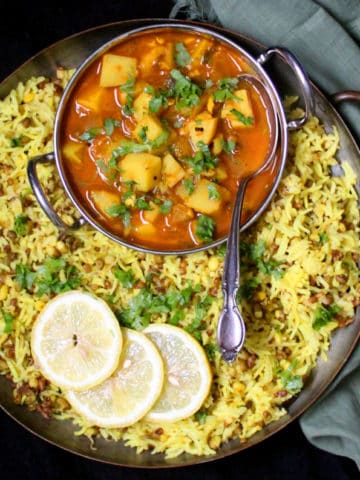
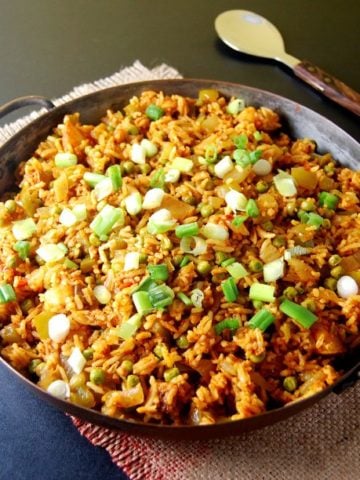
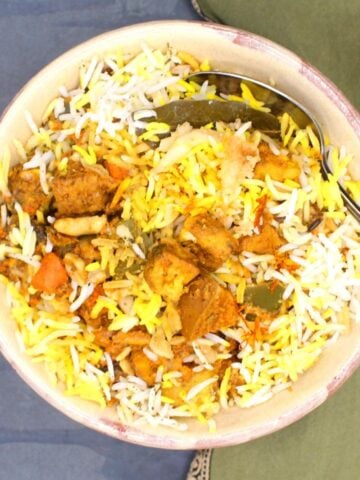
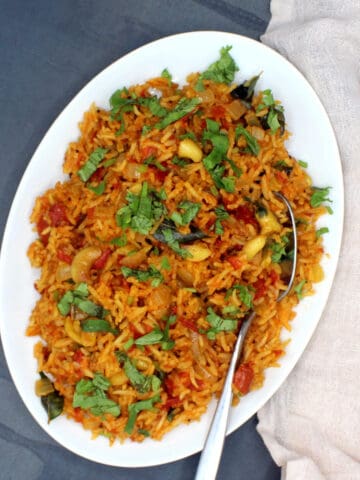
Amanda
I'm not vegan but was looking for a way to use up some dried lentils. I knew from looking at the recipe that this was going to be delicious and it did not disappoint! This was my first time making khichdi. I used basmati rice, went with cayenne (spice level was perfect) sweet potato, red bell pepper and peas for the veg, tomato sauce instead of puree (because I had it in the pantry) and it turned out amazing. Checks all the boxes for me: easy to make, healthy, filling and delicious. Garnished with cilantro and mint and a squeeze of lime. YUM!
Marina
I just made this tonight. Absolutely incredible and will be making this often. Cheap, filling and so very simple to make. I’ve been a vegan for 9 years and ever since have fallen in love with Indian cuisine- this is one of the best yet.
Vaishali
Hi Marina, so awesome you enjoyed the khichdi!
Julia
Originally got something similar to this out of an old Vegetarian Times magazine. I have made it for years. Now I can assign it a name. Thank you!
Vaishali
Awesome. 🙂
Jaswinder Kaur
Very useful recipe.
I love khichdi and make it little different. I don't add any oil and no tadka.
Still it is so tasty and healthy.
Thanks for the recipe.
Vaishali
Thanks. 🙂
Lisa
I know this is a dumb question but do you need to do anything to prepare the dal or rice beforehand?
Aditya Garg
Are you sure the peas are to be added after the khichrie has been cooked? They tasted like raw in my case.
Vaishali
Not if you added fresh peas--the instructions clearly say that if using fresh you need to add them earlier. Frozen peas should be able to easily cook through in the heat from the rest of the khichdi.
Aditya Garg
Ok. So the frozen peas are already pre-cooked. I didn't knew that. Anyways thanks for clearing up.
Ella
This recipe is fantastic! I was looking for a cheap, healthy recipe that I could make large batches of because I have to pack lunches for 3 people every day. This has lots of flavor, is easy to cook, and is highly versatile---you can add whatever veggies you like. I am new to cooking Indian cuisine and I am pleasantly surprised. Thanks for posting!
Pam
I love this recipe because the complex flavors and variety of ingredients make it incredibly satisfying and delicious. I have been searching for vegetarian recipes that make use of unusual (to me) combinations of vegetables, grains and spices and avoid the overuse of cheese. This recipe knocks it out of the park.
Eleanor
I see all the comments but where is the recipe for Masala Khichdi?
Kalpa
Can you use regular eggplant instead of Japanese?
Vaishali
Yes!
John
Amazing meal. The levels of flavors are phenomenal. I've never seen curry leaves so I added just a pinch of curry powder to spice mix. The mint was a perfect addition. I'll be adding this to my recipe rotation. Thanks again.
Jakey
Hey, I bet you could make this in a rice cooker, yes??
Vaishali
Yes!
Khushboo
Tried this khichdi for dinner today.
My husband first time liked Britten rice recipe
He never looked brown rice
But today he loved this khichdi.
Thanks to you, I could make him eat this healthy dish
Mia
This recipe looks absolutely delicous!! I'm going to make this for lunch tomorrow!!